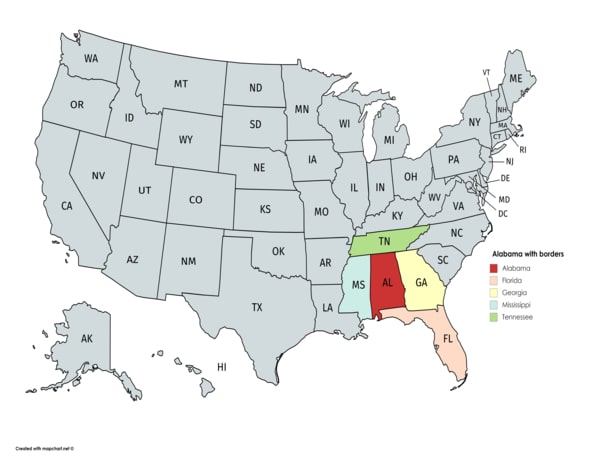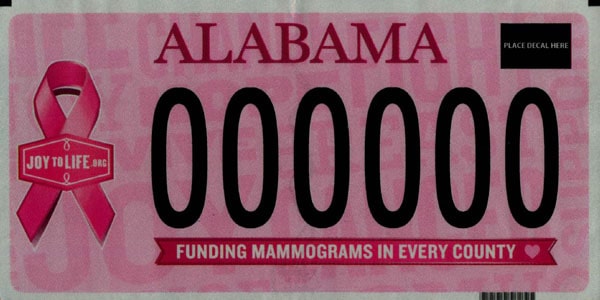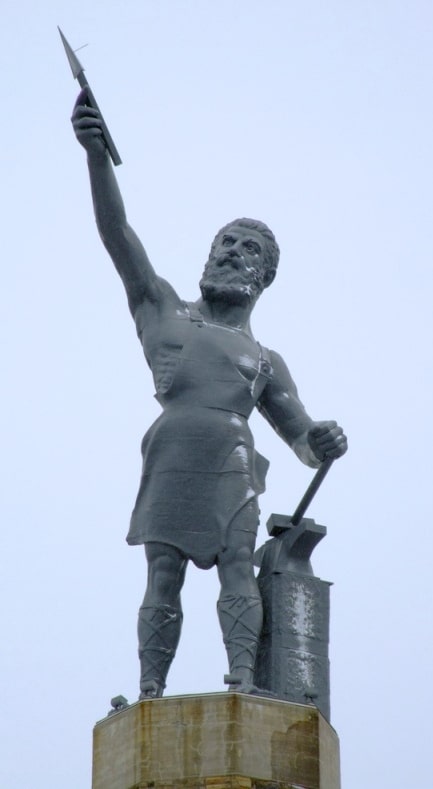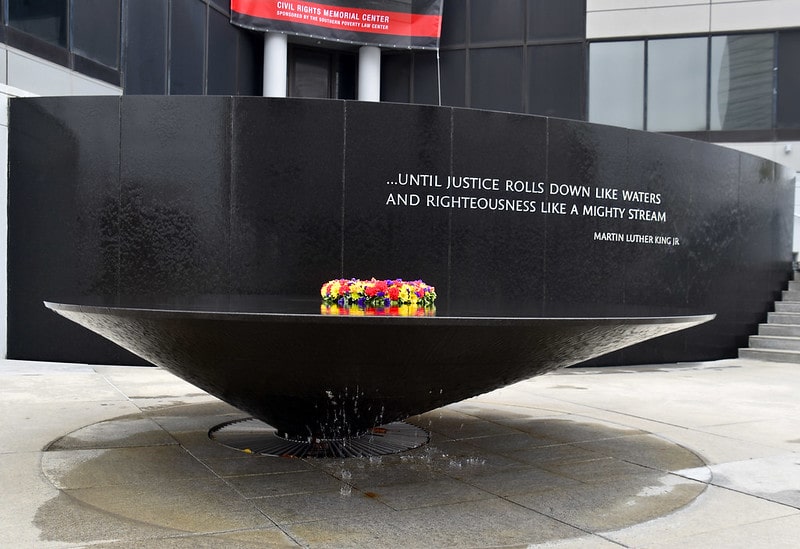Last updated on December 3rd, 2023
Alabama is the 24th most populous and the 30th most extensive of the 50 states of the United States. It lies in the south-eastern region of the United States. The state attained statehood on December 14, 1819, becoming the 22nd state to join the union. It shares its border with four states (Georgia, Tennessee, Florida, and Mississippi.) See the full list of the 50 states and their borders here. Alabama (nicknames: the “Yellowhammer State”, the “Cotton State”, the “Heart of Dixie”) has 67 counties. The state’s capital is Montgomery. The postal abbreviation for Alabama is AL. With these Alabama facts, let us learn more about its history, geography, people, economy and more.
Facts about Alabama
1. The state was named after the Alabama River. The origin of the word Alabama is considered to be from two words “Alba and Amo”. Alba refers to vegetables, herbs, and plants while Amo refers to gatherer or picker. The combination of these words “vegetation pickers” describes the Alabama Indians who were the early settlers in the region.
2. Did you know that the Spanish were the first Europeans to reach Alabama? This happened in 1540. But it was the French who settled first.
3. Founded by the French colonists in 1702, Mobile is the oldest city in the state.
4. Fort Toulouse, established in 1717 near Wetumpka, is Alabama’s oldest continually occupied European settlement.
5. Did you know that Mobile, Alabama is the birthplace of America’s original Mardi Gras? The parade originated in 1703 in port city.
Alabama on the map
6. The Battle of Fort Mims, fought in 1813 during the Creek War, was one of the largest and bloodiest battles of the conflict.
7. The Battle of Horseshoe Bend, fought in 1814 during the Creek War, was a decisive victory for American forces under General Andrew Jackson, leading to the cession of millions of acres of Creek land.
8. The Trail of Tears, the forced removal of Native American tribes from their ancestral lands in the 1830s, passed through Alabama, affecting the Cherokee, Creek, Choctaw, Chickasaw, and Seminole peoples.
9. Did you know that on the night of November 12, 1833, a spectacular occurrence of the Leonid meteor shower had been observed in Alabama? The shower was so intense that many people thought that the world is coming to an end. The “night the stars fell” is mentioned in several stories about Ray County.
10. Did you know that in 1836 Alabama was the first U.S. state to declare Christmas a holiday and Oklahoma in 1907 was the last to do so?

11. The Marion Military Institute in Marion, Alabama, founded in 1842, is the oldest military junior college in the United States.
12. In 1861, Montgomery, Alabama, served as the capital of the Confederate States of America before it was moved to Richmond, Virginia.
13. The Battle of Mobile Bay, fought during the American Civil War in 1864, was notable for Admiral David Farragut’s famous order, “Damn the torpedoes, full speed ahead!”
14. In 1865, Union troops led by General James H. Wilson captured the city of Selma, a key Confederate stronghold, which marked a turning point in the Civil War.

15. The nickname the “Yellowhammer State” originates from the fact that the Confederate troops placed yellow trimmings on their uniform during the Civil War. Yellowhammers are the birds with yellow patches under their wings.
16. The Talladega College in Talladega, Alabama, founded in 1867, is the oldest private historically black college in Alabama.
17. The first African American student to enroll at the University of Alabama was Autherine Lucy Foster in 1956, following a legal battle to desegregate the university.
18. Did you know that Helen Keller, born on June 27, 1880, in Tuscumbia, Alabama, was the first deaf and blind person to earn a college degree? Directed by Arthur Penn, a film “The Miracle Worker” was also produced in 1962 depicting the story of the remarkable tutor Anne Sullivan and Helen Keller.
19. The Birmingham Civil Rights Institute in Birmingham, Alabama, is one of the premier institutions dedicated to preserving and promoting the history of the Civil Rights Movement. It was officially opened to the public on November 14, 1992.

20. On 15 April 1886, Montgomery, became the first U.S. city to initiate an electric streetcar system for transportation, The Capital City Street Railway, also known as the Lightning Route. The system was however retired exactly after 50 years on April 15, 1936, and was replaced by buses.
21. The first African American bank in the United States, the Penny Savings Bank, was founded in Birmingham, Alabama, in 1890.
22. The city of Birmingham was once called the “Pittsburgh of the South” thanks to its booming steel industry during the early 20th century.
23. The last constitution adopted by Alabama in 1901, is the longest of all the state constitutions. The document has more than 376,000 words. Vermont has the shortest constitution (8,565 words) among the 50 states.
24. The world’s first open-heart surgery was performed by Luther Leonidas Hill Jr. in Montgomery, Alabama, in 1902.
25. Tuskegee, Alabama, is renowned for its historic significance in African American history. It was the site of the Tuskegee Institute, founded by Booker T. Washington, and the Tuskegee Airmen, the first African American military aviators.
26. In 1901, Booker T. Washington delivered his now-famous speech called “Atlanta Compromise” at the Cotton States and International Exposition in Atlanta, Georgia, outlining his vision for race relations and economic progress.

27. Mary Anderson, born in Greene County, Alabama, is credited with the invention of windshield wipers. She was granted the patent for her invention in 1903. In 1922, Cadillac became the first car manufacturer to adopt them as standard equipment.
28. In 1904, the St. Andrew’s Bay Hurricane, also known as the Great Dixie Hurricane, devastated coastal areas of Alabama, Florida, and Georgia, causing extensive damage and loss of life.

29. In 1910, Wright brothers opened the first-ever in the U.S. civil aviation school on an old cotton plantation on the outskirts of Montgomery, Montgomery County. However, the flight school did not remain operational for a long time due to some problems.
30. The Alabama state motto is “Audemus jura nostra defendere,” which means “We dare defend our rights” in Latin. It was adopted during a joint resolution of the Alabama State Legislature on February 12, 1923.
31. The famous Scottsboro Boys case highlighted racial injustice in Alabama in the 1930s. It involved nine African American teenagers falsely accused of rape.
32. The arrest of Rosa Parks in 1955 when she refused to give up her bus seat to a white man in Montgomery became a key event in the civil rights movement. She is called “the mother of the civil rights movement”.
33. The Freedom Rides, a series of civil rights protests against segregation in interstate transportation, began in Montgomery, Alabama, in 1961 and played a significant role in the desegregation of public transportation.

34. The Vulcan statue, the city symbol of Birmingham, Alabama, is the largest cast iron statue in the world. The 56-foot tall statue (from toe to spear point) depicting the Roman god Vulcan is the world’s largest iron-ore statue. It weighs 101,200 pounds. The statue was designed by the Italian artist Giuseppe Moretti.
35. The Civil Rights Memorial in Montgomery, Alabama, honors those killed in the struggle for racial equality. The memorial also has a timeline of key events and the names of the 40 victims etched in black granite. The memorial was designed by Vietnam Veterans Memorial designer Maya Lin. It is located on an open plaza accessible to visitors 24 hours a day, every day of the week.
36. On January 11, 1961, Alabama seceded from the Union. The delegates from six states met at Montgomery and formed the Confederate States of America. Montgomery was chosen as the capital. Because of this, Montgomery is known as the “Cradle of the Confederacy.” The Confederate flag was designed and first flown in AL in 1861.
37. In 1963, the 16th Street Baptist Church in Birmingham was bombed by members of the Ku Klux Klan, resulting in the deaths of four young African American girls.
38. The Selma-to-Montgomery march in 1965 guaranteed the right to vote to all African Americans. Martin Luther King Jr. participated in the march. He had recently won the Nobel Peace Prize in 1964, which helped him draw attention to the difficulties faced by black voters, and the need for a national Voting Rights Act.
39. On February 16, 1968 a Senator in Haleyville placed the first 911 call. Before that first call, citizens needed to dial local 10-digit phone numbers to reach police, fire or emergency services.
40. Did you know that Martin Luther King, Jr. began his career as a local pastor at Dexter Avenue Baptist Church in Montgomery?

41. “Until justice rolls down like waters and righteousness like a might steam.” – These are his words that are inscribed on Montogomery’s Civil Rights Memorial.
42. The Edmund Pettus Bridge in Selma, Alabama, gained significant historical importance as the site of the Bloody Sunday confrontation during the Civil Rights Movement in 1965.
43. Home of Martyrs: the Montgomery Civil Rights Landmarks make a memorial center for leaders who died during the 1954-68 civil rights war. There is a Wall of Tolerance whereby guests pledge to fight against hate and uphold tolerance.

44. Did you know that Saturn V, the rocket used by NASA to send people to the moon, was developed at NASA’s Marshall Space Flight Center in Huntsville, Alabama? The first Saturn V was launched in 1967. The rocket was about the height of a 36 story-tall building and weighed about the weight of about 400 elephants.
45. Explorer 1 was the first successful U.S. satellite. It was launched on Jupiter C rocket, which was built at the Army Ballistic Missile Agency in Huntsville, AL. The satellite was launched on January 31, 1958, from Cape Canaveral, Florida. The satellite orbited Earth every 114.8 minutes, making 12.54 orbits each day.
46. Interestingly, due to the presence of a rocket building facility in Huntsville, it (Huntsville) earned the name “Rocket City U.S.A.”
47. The United States Space & Rocket Center in Huntsville houses one of the world’s largest collections of space artifacts, including the iconic Saturn V rocket and the Space Shuttle Pathfinder.
48. In 1996, an Alabama law was passed that made it illegal to hold Bear Wrestling matches for a profit. Later, it was repealed because it was seen as outdated and obsolete. However, it’s still illegal to host or engage in now due to laws pertaining to animal treatment and cruelty.

49. Did you know that Mercedes Benz established its first U.S. factory in Vance, Tuscaloosa, Alabama? It was also the first-ever automobile factory in the state. The plant started producing cars in January 1997.
50. The world’s largest cast-iron skillet is located in the town of Fort Payne, Alabama. It measures 14 feet in diameter and weighs approximately 8 tons.
51. Enterprise, Alabama, is home to the Boll Weevil Monument, which was erected in 1919. It was erected to honor the insect that inadvertently led to a shift from cotton farming to more diversified crops, ultimately benefiting the economy.
52. Condoleezza Rice, the first African-American women to serve as U.S. secretary of state was born in Birmingham. Note that Birmingham is also the state’s largest city.
. . . continue reading on the next page
